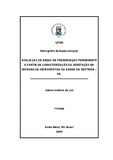| dc.contributor.advisor | Pereira Filho, Waterloo | |
| dc.creator | Luz, Glênio Antônio da | |
| dc.date.accessioned | 2014-09-17T15:19:59Z | |
| dc.date.available | 2014-09-17T15:19:59Z | |
| dc.date.issued | 2005-03-15 | |
| dc.date.submitted | 2005 | |
| dc.identifier.uri | http://repositorio.ufsm.br/handle/1/478 | |
| dc.description | Monografia (especialização) - Universidade Federal de Santa Maria, Centro de Ciências Naturais e Exatas,Curso de Especialização em Geociências, RS, 2005. | por |
| dc.description.abstract | In the past the development of the society almost depended that totally of
the agricultural section and even in the present it consists of an important
activity. As the areas were increased for the agriculture were also reduced
the areas of forests, this fact is visible through the observation of the
terrestrial surface. With the reduction of the areas of forests if he/she had
a reduction in the control of the flow and of the erosion of Microbacia
Hidrográfica of Sanga of the Sandbank, this easiness to cause the
increase of the flow picks and assoreamento of the bed of the courses
hídricos resulting in inundations and losses of fertile soil for the erosion.
This work has as main objective to identify the vegetation classes in the
microbacia hidrográfica through NDVI (Index Differentiated Normalized of
Vegetation) done with the images of the satellite Landsat 7, Sensor ETM+
of the year of 2000. They were established the following classes: exposed
soil, I sole partially exposed, fields, vegetation arbustivas and arboreal
vegetation. It was observed that there is the domain of fields following by
vegetation arbustiva, soil with little vegetation, arboreal vegetation and I
totally sole exposed of the class fields it was observed that in the area the
predominant economical activity is the livestock following by the
agriculture, however the most important class for the balance and the
stability of the microbacia hidrográfica is the class of arboreal vegetation
x and vegetation arbustiva, for they be class that you/they delay the effect
amount of water of the rains. | eng |
| dc.language | por | por |
| dc.publisher | Universidade Federal de Santa Maria | por |
| dc.rights | Acesso Aberto | por |
| dc.subject | Geociências | por |
| dc.subject | Geografia | por |
| dc.subject | Sensoriamento remoto | por |
| dc.subject | Bacia hidrográfica | por |
| dc.title | Avaliação de áreas de preservação permanente a partir da caracterização da vegetação na microbacia hidrográfica da Sanga da Restinga-RS | por |
| dc.title.alternative | Evaluation of areas of permanent preservation Starting from the characterization of the vegetation in microbacia hidrográfica of Sanga da Restinga- RS. | eng |
| dc.type | Trabalho de Conclusão de Curso de Especialização | por |
| dc.degree.local | Santa Maria, RS, Brasil. | por |
| dc.degree.specialization | Geociências | por |
| dc.description.resumo | No passado o desenvolvimento da sociedade dependia quase que totalmente do setor agrícola e até mesmo no presente consiste em uma atividade importante. Conforme foram aumentadas as áreas para a agricultura também foram reduzidas as áreas de matas, este fato é visível através da observação da superfície terrestre. Com a redução das áreas de matas se teve uma redução no controle da vazão e da erosão da Microbacia Hidrográfica da Sanga da Restinga, esta despreocupação poder ocasionar o aumento dos picos de vazão e assoreamento do leito dos cursos hídricos resultando em enchentes e perdas de solo fértil pela erosão. Este trabalho tem como objetivo principal identificar as classes de vegetação na microbacia hidrográfica através do NDVI (Índice Diferenciado Normalizado de Vegetação) feitas com as imagens do satélite Landsat 7, Sensor ETM+ do ano de 2000. Foram estabelecidas as seguintes classes: solo exposto, solo parcialmente exposto, campos, vegetações arbustivas e vegetações arbóreas. Observou-se que há o domínio de campos seguido de vegetação arbustiva, solo com pouca vegetação, vegetação arbórea e solo totalmente exposto da classe campos observou-se que na área a atividade econômica predominante é a pecuária seguida da agricultura, entretanto a classe mais importante para o equilíbrio e a estabilidade da microbacia hidrográfica é a classe de vegetação arbórea e vegetação arbustiva, por serem classe que retardam o efeito quantidade de água das chuvas. | por |
| dc.publisher.unidade | Centro de Ciências Naturais e Exatas | por |


